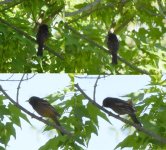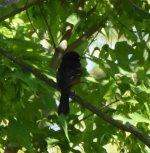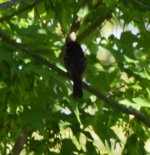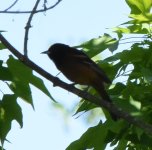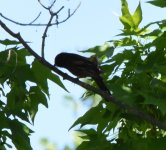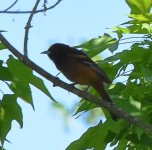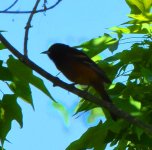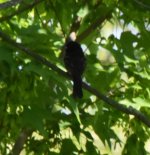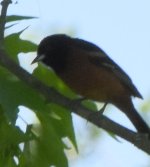Can anyone identify the bird in these four photos? They are all the same bird. I took the photo at Croton Point Park in Croton, NY. It was in a tree in a mixed woodland/grassland area near a bay. The bird is about the size of a sparrow or warbler. Thanks for any suggestions.
-
Welcome to BirdForum, the internet's largest birding community with thousands of members from all over the world. The forums are dedicated to wild birds, birding, binoculars and equipment and all that goes with it.
Please register for an account to take part in the discussions in the forum, post your pictures in the gallery and more.
You are using an out of date browser. It may not display this or other websites correctly.
You should upgrade or use an alternative browser.
You should upgrade or use an alternative browser.
Unidentified Warbler-Sized Bird in Croton, (Hudson Valley), NY (1 Viewer)
- Thread starter gsimonel
- Start date
More options
Who Replied?Yes it must be. I don't think I've seen one this yellow...Baltimore Oriole - slightly bigger than sparrows (except fox sparrows), but you'll read the phrase "estimating the size of a bird is unreliable" pretty often on this site.
nartreb
Speak softly and carry a long lens
Looks pretty normal to me. The bird is in shadow against a bright background, so you can expect the color not to be perfect, but even without that effect it's not really rare to see Baltimores in a yellowy shade of barely-orange. https://www.allaboutbirds.org/guide/assets/photo/306381591-1280px.jpg
'tis for me but then I've only seen them in central, South AmericaLooks pretty normal to me. The bird is in shadow against a bright background, so you can expect the color not to be perfect, but even without that effect it's not really rare to see Baltimores in a yellowy shade of barely-orange. https://www.allaboutbirds.org/guide/assets/photo/306381591-1280px.jpg
Boy, I wish I had taken that photo!Looks pretty normal to me. The bird is in shadow against a bright background, so you can expect the color not to be perfect, but even without that effect it's not really rare to see Baltimores in a yellowy shade of barely-orange. https://www.allaboutbirds.org/guide/assets/photo/306381591-1280px.jpg
birdmeister
Well-known member

I was thinking Orchard Oriole. Thin bill, long and slim tail, less contrast between black and rich rufous, and the OP's impression of size would be closer (I admit that size alone shouldn't be the deciding factor). What looks like a paler lower belly might not fit adult male Orchard, but maybe that's down to the heavy greenish cast in the photos.
It is entirely possible that I messed up the color when I tried to lighten the images. I'll repost all 4 original images without any processing other than cropping. Then maybe if anyone with more photo processing experience wants to make any adjustments they can get a better idea of the true color.
Attachments
AveryBartels
Well-known member
Agreed with birdmeister, my initial impression is Orchard. The smaller more slender bill is a better fit for that species in addition to what they mentioned.
nartreb
Speak softly and carry a long lens
I played with the 3041 photo a bit since that one showed the most color. Here is the result of adjusting the "curves" (brightening the darker parts without otherwise adjusting the colors). As you can see from the graininess, we are pushing the image to try to show us information that is at best partially recorded in the first place. Here is the setting that seemed closest to "right" (if you push too far for brightness, things turn grey; if you don't push enough, you just see black.) I think you could interpret it either as a brownish-chested bird showing oddly yellow in places, or a yellowish bird in deep shadow that got recorded as browner due to shadow. It appears that the chest is darker/more colorful than the belly, which I think fits baltimore a little better but I guess is also true for Orchard, and might just be an effect of shading. That wingbar looks quite yellow to me, not chestnut at all, but that's a pretty slim reed to cling to.
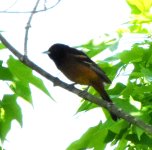

nartreb
Speak softly and carry a long lens
Of course I can also put a thumb on the scale and mess with, say, just the yellow, until the bird looks more like one species or the other, but the results look very unnatural (e.g. leaf color) so I won't bother sharing those. Conclusion: it's not some systematic "everything in the shot is too yellow" problem (as might occur with incorrect white balance setting in the camera). (If there's any "greenish cast", it's pretty slight. Reducing the greens or shifting them toward another part of the color space just looks awful.) It's just a tough shot into shadow that doesn't let the camera get good color, and/or a weird-colored bird.
I have no chance of distinguishing an orchard from a baltimore based on tail length or beak shape (can we even tell what angle the beak is pointing at?), so I'm inclined to stick with my first impression of Baltimore based on what I think I see in the color.
I have no chance of distinguishing an orchard from a baltimore based on tail length or beak shape (can we even tell what angle the beak is pointing at?), so I'm inclined to stick with my first impression of Baltimore based on what I think I see in the color.
Last edited:
Hmmm looked at this again. I feel we can't be sure about the precise bill shape given image quality. However, I feel very slightly more confident that it's bicoloured. That should make this orchard. Your playing with colours strengthens this: even if it were originally yellow (in life) then that's better for orchard. I have seen orchard Orioles that colour...
After reading the above posts, I went through my recycle bin to see if any of the rejected photos could shed a little light--okay, pun intended--on the bill. I found two photos that might be helpful. I've cropped them and lightened the midtone levels very slightly in Photoshop. I think they both argue for a bicolored bill. So for now, unless someone points out something else to consider, I'm going to assume this is an orchard oriole.
Thank you to everyone who contributed to this ID for me. I really appreciate the earnest, collaborative discussion.
Thank you to everyone who contributed to this ID for me. I really appreciate the earnest, collaborative discussion.
Attachments
Users who are viewing this thread
Total: 2 (members: 0, guests: 2)




